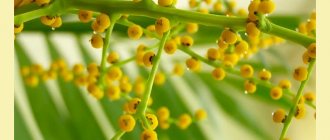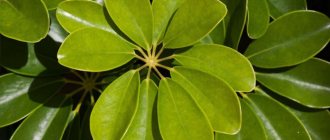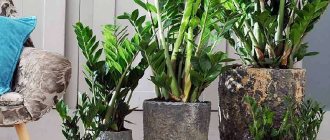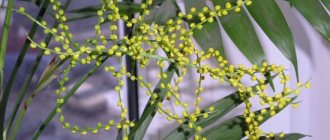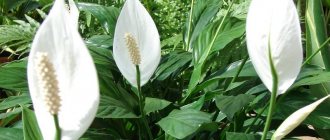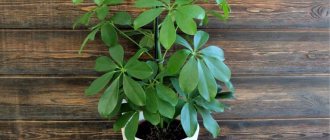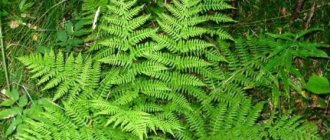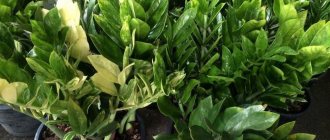Caring for an indoor Hamedorea flower should be special and correct. This is the only way your palm tree will grow beautiful.
House palms are a very popular and popular type of indoor plants. They are distinguished by their unusually beautiful appearance, which is not surprising, because they are exotic. One of the most beloved species of this plant among gardeners is Hamedorea .
It is noteworthy that this is not just a beautiful indoor flower. There are many beliefs and signs associated with this representative of the Palmovs. Therefore, it is not surprising that the interest of lovers of unusual home flora in the plant is growing. Read more below.
Where is the homeland of the domestic flowering Hamedorea palm tree: types, varieties, how it blooms, photos
Hamedorea blooms
Hamedorea is a perennial flowering plant native to the tropics. The flower is widespread in East Africa, Central America, and Madagascar . Also, several varieties of palm grow on the Crimean Peninsula, southern Europe and the Caucasus .
The characteristics of a flower directly depend on its variety. There are many varieties of this home flowering palm tree - indoor Hamedorea. Below you will find photos of some species and see how the plant blooms. The most popular types are:
Hamedorea graceful (elegans)
Hamedorea graceful (elegans):
- It is a perennial single-stemmed plant, growing up to 1.5-2 m in height .
- The trunk has a smooth surface and is covered, as a rule, with 6-7 pinnate leaves .
- Each of them is divided into 8-15 segments of a dark green hue, having a narrow lanceolate shape.
- The inflorescences are panicles, loose in texture, formed by cobs. The latter, in turn, consist of orange-red flowers.
- After the end of the flowering cycle, black berries appear in place of the flowers.
Hamedorea Ernest-August
Hamedorea Ernest-August:
- This type of flower has leaves that are dark green and not divided into segments.
- They look like large and wide plates, sometimes bifurcating at the tips.
- The plant does not have particularly vigorous growth. On the contrary, the pace of its development is slow.
- In general, this type of palm is characterized by a stem form. This means that one rhizome can produce only one stem.
- This culture blooms with red spherical flowers, which are collected in spreading inflorescences.
Hamedorea high
Hamedorea high:
- Already from the name you can roughly understand what the main features of this type of plant are.
- The stems of indoor culture are erect, similar in appearance to bamboo.
- When the leaves at the bottom fall off, and light ring-shaped spots appear instead.
- At the top of the stem there are 4-6 dark green pinnately dissected leaves.
- The narrow-lanceolate lobes are pointed at the edges.
- The plant blooms very beautifully, producing bright orange flowers that form panicles.
Hamedorea unicolor
Hamedorea unicolor:
- This is the most unpretentious type of indoor palm tree among all varieties. That is why it is often the choice of flower growers.
- The shoots of the plant grow slowly and rarely reach more than 100 cm in height.
- The form is characterized as bushy, which is facilitated by the formation of several thin additional shoots.
- At their tops there are leaves of a light green color and pinnately dissected shape.
- Hamedorea unicolor is distinguished by the rapid onset of the flowering period.
Hamedorea metallic
Hamedorea metallic:
- This type of palm tree has leaves that are dark green with a metallic tint. Due to this, this type of flower got its name.
- The leaves of the plant are solid and wide.
- As it develops, the palm trunk thickens and becomes woody.
- A palm tree growing in nature can reach 2 m in height , but in a flower pot where space is limited it will be smaller.
- The culture is characterized by good shade tolerance.
Hamedorea bridble
Hamedorea bridble:
- This representative of exotic indoor plants can grow up to one and a half meters. But it is noteworthy that this palm variety is a hybrid of the popular variety Elegance .
- However, the specimen in question has larger, brighter flowers, and the leaves and shoots are colored emerald.
- Proper care allows the plant to form a lush vegetation mass. It is characterized by an attractive appearance.
Of course, there are many more varieties of Hamedorea . About 120 species of this exotic plant are known But the most popular in home floriculture are the above-mentioned specimens.
Hamedorea palm: who is it and where does it come from?
Coming to us from the tropical rainforests of Mexico, Guatemala, Yucatan, the chamedorea (or neanta, bamboo, mountain, reed palm) is unpretentious, does not require a lot of sun, but loves water. It most often appears as a low woody plant, with one or many stems, sometimes like a vine. In its homeland, in South and Central America, chamedorea grows in the foothills, often under tall trees, in the middle and lower tiers of forests.
It has whole, forked or feathery leaves (depending on the type), small red, orange or yellow pleasantly smelling flowers collected in inflorescences; the fruit grows no larger than a pea. This palm begins to bloom and produce fruit early. The flowers of one of the species of this plant (male) are used by South Americans for food (as we use vegetables for salad).
Note! Hamedorea is dioecious; in order to flower, a male and a female plant must be nearby. If seed propagation is not planned, flowers can be removed at the bud stage so as not to weaken the plant.
This flower is hardy, small (one and a half to two meters compared to its wild counterparts, which grow up to five meters in height in nature) and unpretentious. As practice shows, chamedorea can tolerate irregular watering, a cramped pot and unfertilized soil without much damage. Its leaves in indoor conditions are only 30 centimeters long. All this makes chamedorea very suitable for indoor cultivation.
chamedorea blooming
It reproduces by seeds or root shoots, perfectly purifies the air, but germinates slowly, like all palm trees. Seeds can remain in a pot for more than six months without any sign of germination. And even a sprouted seedling produces on average one or two leaves per year. Therefore, tall, mature flowers are much more expensive on the market, and if a small seedling grows, you should be patient.
X. cascade
Hamedorea: signs and superstitions
There are many signs and superstitions regarding the presence of certain plants in the house. For example, there is a well-known superstition that you should not bring lilacs into your living space, as this promises death to someone close to you. But all this is nothing more than a stupid fiction, in no way confirmed by real facts.
What about the Hamedorea palm? Are there any signs here - good or bad? Of course yes. Here are a few of them:
- Hamedorea is a source of powerful energy, so its presence in a room or office has a beneficial effect on the overall microclimate.
- In the room where the flower grows, people are filled with energy and get rid of the feeling of depression.
- All undertakings and plans will come true for the person caring for the exotic plant.
- The situation in the family is improving, misunderstandings, disagreements and scandals are becoming a rarity.
- Energy vampires try to stay away from people in contact with Hamedorea
- It is contraindicated for selfish individuals to keep such a palm tree next to them, because they may completely lose sensitivity to the feelings of family and friends.
- If there is coziness, tranquility and harmony in the house, then light and lush foliage predominates on the flower. If the branches darken and begin to wither, this indicates the presence of evil spirits and evil energy. By giving away its vital energy, the palm tree tries to cleanse the aura in the house.
Today it is generally accepted that Hamedorea brings only goodness to its owner. Thus, a person who takes care of a flower becomes more self-confident, calm and reasonable. But everything, of course, depends on one more subtlety - vocation. Thus:
- For creative individuals, the palm tree promises recognition, fame and success.
- For businessmen, the flower helps realize commercial plans.
- For athletes who love to care for Hamedorrhea, the indoor plant helps them reach new heights.
However, there is a negative superstition. Our ancestors believed that Hamedorea in the house brings misfortune and trouble. To avoid them, you need to bring the palm tree into the house correctly. Or rather, not bring it in in a pot, but bring it in on wheels, so carts, strollers and other small vehicles were used to transport the plant.
It is up to you personally to believe the signs and superstitions associated with the exotic flower in question. People are now less inclined to follow the warnings that their ancestors trusted.
Variety of species and varieties
There are about 130 wild species of Hamedorea. There are few indoor plants. They are especially popular for their original feather-like leaves:
- Elegance - grows in the form of a bush, consisting of several small trunks, reaching about 1.5 meters in height. It blooms with many yellow flowers that spread aroma.
- Tall chamedorea is a rich green bush. It begins to bloom three years after it is planted, its buds are orange.
- Hamedorea unicolor is a very common species among domestic palms. A bushy plant consisting of light green leaves on thin stems, up to one meter long. Blooms with faded yellow buds.
- Ernesta Augusta is not a very common species. Consists of a single trunk with broad foliage. Blooms with buds of rich red color.
- Hamedorea bridble (photo) is a relatively recently bred variety, it has a lot in common with elegans, the only difference is in the size and shade of the flowers, they are larger and richer. Caring for the plant at home is required in the same way as for the varieties described above.
It should be noted that the Hamedorea palm tree (photo), with proper care, begins to bloom at home only 3-4 years after it was planted; this is one of the features of the plant.
Hamedorea plant: features of growing at home after purchase
Hamedorea plant
The Hamedorea plant is a flower that requires care. Provide it with optimal growing conditions - and it will please your eyes all year round. Study the features of growing a flower at home after purchase. The intensity of growth and development of culture depends on:
- Temperature indicator in the room
- Air humidity level
- Lighting
- Frequency and abundance of watering
- Substrate composition
- Added fertilisers, fertilizers
- Transplants
Do not forget that the flower needs shading, so place it away from intense light radiation. Also provide the flower with frequent watering. Avoid letting the soil dry out, otherwise the palm tree will simply die.
Diseases
For successful treatment, it is important to recognize the disease that affects chamedorrhea in time. This is not always easy to do.
Damage to the root system, for example, occurs below the soil surface. But, even in this case, there are certain external signs that will tell the grower about the onset of the disease.
Wilting of shoots
The problem can be recognized by the appearance of brownish spots of rot with white spores . The flower begins to fade.
What to do?
- If measures are not taken in a timely manner, the plant will die. The pot is thrown away along with it or thoroughly washed and disinfected with a solution of potassium permanganate.
- If the lesion is minor, treat twice with a solution of acarin, actellik or other special preparations.
- Maintaining temperature and proper hydration are excellent preventive measures.
Fusarium wilt of shoots
It affects individual shoots, which become faded, gradually wither and die . The disease does not affect the root system. If there is high humidity in the room, the base of the trunk begins to quickly rot and becomes covered with a red coating of spores.
What to do?
- Monitor soil moisture, room humidity and temperature conditions.
- In case of minor damage, treatment with special preparations is required: actellik or phytoferm.
- If the damage is deep, it will not be possible to save the flower. They throw him away. The container can be thoroughly rinsed, doused with boiling water and potassium permanganate.
- It is advisable to carry out work wearing silicone gloves using special tools. After use, they are thrown away or disinfected.
Anthracnose
The leaves are covered with small light spots, which over time change color to brown, the edges become convex with a yellowish border. The spots are located chaotically, merging when the lesion is deep.
What to do?
- Indoors, it is recommended to reduce air humidity, stop spraying leaves, and strictly adhere to the watering regime.
- The palm tree is treated with Rovral.
- Deep damage leads to death. The flower is thrown away and the container is disinfected.
Hamedorea flower blooming
The Hamedorea flower begins to bloom in the 3rd year from the moment it is planted in a pot. And if several specimens are placed in one container at once, they will bloom alternately. The yellow flowers have a pleasant scent and their appearance resembles a mimosa.
Important: Experts advise removing flower stalks from young palm trees, since the palm tree spends a lot of vital energy on their formation and development. As a result, its overall growth slows down. If this happens, use fertilizing and fertilizers.
Hamedorea pests and diseases
Among the pests, Neantha can be affected by spider mites, aphids, scale insects and mealybugs. The bamboo palm is resistant to harmful insects, but dry air and contaminated soil can lead to their appearance
If the leaves of Hamedorea begin to turn yellow and dry, carefully examine them from the underside, and also pay attention to the trunk:
- spider mites can be recognized by very small moving dots and cobwebs between the leaves;
- scale insects look like gray or brown plaques that are difficult to tear off;
- green or gray aphid insects can settle on the table and the top of the tree;
- Mealybugs look like pieces of cotton wool.
All these insects feed on the sap of the plant, which is why the leaves first lose their decorative appearance, and soon dry out and fly off. Pests can be destroyed using special insecticidal preparations.
When the soil in the pot stagnates, the air in the room is cold, and the soil is contaminated, chamedorea can be affected by diseases in the form of pink rot or leaf spot:
- Pink rot
affects the roots of the palm tree, and wet pink, brown or brown spots appear on the leaves and trunk. After some time, the trunk rots and the plant dies. To cure chamedorrhea, you need to change the soil, trim off the rotten roots, and treat the remaining ones with a fungicide. - Leaf spot
is a fungal disease that appears as oval or round spots on leaves that are gray, brown, light green, brown, white or yellow. The fungus multiplies quickly and soon the leaves wither completely. It is necessary to reduce watering, trim off affected leaves and spray the bush with a fungicidal preparation.
Temperature regime of the Hamedorea flower when kept at home
It is very important to provide the Hamedorea flower with optimal temperature conditions in the room where it grows. When maintaining a house, the plant reacts very sharply to heat, so in summer the room should be regularly ventilated. This will be enough to ensure that the exotic flower does not die, but fully develops and grows.
As for the cold season, try to maintain the temperature in the room at +12 - +18 degrees . However, do not allow drafts or hypothermia, although the plant survives calmly even in critical conditions.
Spraying the Hamedorea plant
An equally important condition for flower growth is the level of humidity. Its optimal indicator is 50%. When growing a Hamedorea plant in a house or apartment, do not forget to spray it every day. To do this, use settled water or liquid that has previously been passed through a special filter. Ordinary tap water will not work, as it contains many hard impurities that can harm the palm tree.
Some gardeners note that daily spraying is not necessary. It is enough to carry out the procedure twice a week, and in winter even once every 7 days .
How to fix the problem
Hamedorrhea, the leaf diseases of which can be seen in the photo, is very rarely subject to infections. The cause of the disease is improper care. To eliminate the problem, it is worth trimming the shriveled leaves, trimming the damaged tips and providing the plant with partial shade, humidity and a stable temperature.
If the cause of yellowness is waterlogging of the soil, and rotting of the root system is detected, there is only one way out - replanting the plant, during which all damaged parts are cut off.
Systemic insecticides - Fitoverm, Vertimek, Actellik - will help cope with insects. They are used several times with an interval of 10-14 days. But chemicals won’t help you deal with scale insects. They fight it only mechanically: using a toothbrush, remove insects from leaves and shoots. You can also use a cotton swab soaked in alcohol.
When fungal diseases occur, complex fungicides are used.
Feeding the plant should also be regulated, since an excess of potassium leads to yellowness. It is recommended to alternate organic and mineral preparations.
Hamedorea is a heat-loving palm tree. She reacts painfully to sudden changes in temperature or to watering with cold water. Exot needs spraying and showering in hot summers and does not tolerate waterlogging in the winter. Loves nutritious organic matter and is afraid of drafts. By providing chamedorea with such conditions, you don’t have to worry about its diseases - a strong plant will cope with troubles on its own.
Hamedorea: lighting and watering
Hamedorea
a pot with a Hamedorea near a window facing east. This will be useful for the flower, and also beautiful for the overall interior of the room. The best lighting for this plant is sunlight, but not strong, not scorching, but a little in the morning.
Now about watering:
- In hot months, it is absolutely unacceptable to allow the soil in the pot to become too dry. Therefore, hydration of Hamedorea must be regular and plentiful.
- Water your home palm tree 2-3 times. at 7 days
- It all depends on how hot and dry the weather is. But also avoid overwatering, as it is harmful to the flower.
In winter, it is enough to water the crop only once a week . This will maintain the vitality of Hamedorea and prevent the roots from rotting.
Reproduction methods
Hamedorea can be propagated in several ways. One of the most famous methods is using root shoots. They are planted in separate pots with pre-prepared soil.
Another way is to divide the bush. An adult plant must be carefully removed from the pot and separated into several parts. It is important to ensure that each resulting plant has well-formed shoots and a root system.
Pot and soil for indoor Hamedorea flower
Flower growers cannot say unequivocally about which pot to choose for planting Hamedorea. Some botanists believe that a palm flower should initially be planted in a large container. Other connoisseurs of exotic plants in the house note that the pot should be small, so a container with a slightly larger diameter than the previous one, but not too deep, is better suited. But you will still have to replant the palm tree as it grows, so select the container for it at your discretion.
Pay due attention to the composition of the soil for the growth of this plant. Ideally, it should consist of the following components:
- Sand
- Peat
- Special soil (leaf)
Take all components in equal proportions - 1 tsp . Consider the soil pH , which is ideally 5-6.5.
If you are planning to buy a ready-made substrate, then experts advise giving preference to “Palma”. Add a little sand to the soil, mix, put the mixture in a container - and you can start planting Hamedorea.
How to transplant chamedorea correctly
Hamedorea needs to be replanted infrequently - immediately after purchase and as it grows, approximately every two to three years. The optimal time for this is April. You need to purchase ready-made soil for palm trees and a larger pot than the previous one.
You can prepare the soil mixture yourself. To do this, mix humus, turf, sand and peat. The soil should be light, well permeable to air and water.
For replanting, prepare a pot, which must have drainage holes, and a soil mixture. Hamedorea is carefully pulled out of the old pot and transferred to a new one. After this, the plant is watered and placed in the shade.
In the first six months after transplantation, the flower does not need fertilizer. It is advisable to feed it every two weeks in the summer. To do this, use a special palm fertilizer, which is sold in flower shops. There is no need to feed Hamedorea in winter.
Feeding and fertilizing the houseplant Hamedorea
It is necessary to feed the houseplant Hamedorea during its active flowering phase. That is, the flower needs nutrients most of all in the summer. It is enough to use a universal fertilizer, for example Agricola . It should be used at intervals of 14-28 days. Be sure to dilute the fertilizer with water, since the concentrate is quite strong.
Worth knowing: In cold weather, when the dormant period begins, Hamedorea does not need to be fed.
Fertilizer
The plant requires feeding during the period of vegetative propagation. It falls in the spring-summer period (from April to August). Occurs up to twice a month. Specially designed mineral granules or solutions are used for fertilizer.
Hamedorea, unlike other palm trees, needs rich feeding. Once a month it is necessary to apply fertilizer in the form of granules, which are released very slowly.
Transplanting a Hamedorea plant
Transplanting the Hamedorea plant
Young specimens of the Hamedorea plant require annual replanting. At the same time, buy a larger pot each time, because the flower is constantly growing and developing. Therefore, it requires more space.
As for adult plants, they need to be replanted when the roots become visible through the hole in the bottom of the container. In such a case, carry out the procedure once every 4-5 years - this will be enough.
Remember: Adult Hamedorea does not tolerate planting well. Therefore, before you begin, remove the top layer of soil and replace it with a new substrate.
Transfer
Young plants are replanted annually, adults - as necessary, if the roots have occupied all the free space, or once every three years. The top layer of earth is cleared off, but the earthen lump should remain. If the roots do not fit into the pot, they are partially cut off (the lower, matted part).
When replanting, it is necessary to treat wounds and cuts, remove old and diseased leaves. It is worth remembering that the pot for replanting should be, on the one hand, spacious enough, and on the other, not too large.
Also, before transplanting, the plant is watered properly. Having carefully removed the flower from the previous pot, it is carefully, together with a lump of earth, rearranged into a new pot, where the substrate has already been prepared. Then the soil is added and compacted. After transplantation, the plant is placed in the shade for several days; there is no need to water it at this time.
Attention! When replanting, the flower should not be buried: the soil level should be the same as before replanting.
Pruning a Hamedorea flower: when is the best time to do it?
Pruning a Hamedorea flower is not a necessary measure if the flower is growing well. When is the best time to do it? If large brown spots begin to appear on the surface of its leaves, then such green mass must be removed. Also, trim leaves back to living, healthy tissue if they turn yellow.
Perform pruning using sharp scissors. Pre-treat them with alcohol - this is a mandatory disinfection measure. Lubricate the cut areas with a fungicidal preparation to prevent infection from joining the “wounds”.
Types of Hamedorea for indoor growing
| View | Description |
| Hamedorea elegans (Neanta) | Suitable for beginner gardeners. The leaves are located on long petioles. |
| Seifritz | Not demanding on watering. The stems are similar to bamboo. |
| Ernest August | The difference between this palm is that it has solid leaves with serrated edges. |
| Metal | Beautiful metallic tint of leaves. |
| Single color | Green long dissected leaves. |
Growing Hamedorea flower from seeds
Growing a Hamedorea flower from seeds
Hamedorea can be bought in a pot at any flower retail outlet. However, many gardeners prefer to grow palm trees from seeds, despite the fact that this is quite painstaking work. If you want to grow an exotic flower from scratch, then remember a few important rules.
Seed selection:
- Choose only the freshest and highest quality grains. Look at each of them carefully. There should be no signs of damage, rot or mold on the surface.
- If you take old grains, there is a risk that most of them will not germinate. Not surprising, since their germination rate decreases by 10% every year.
- For this reason, when purchasing a package of Hamedorea , carefully study the dates.
- The age of planting material should not exceed 10 months .
- If for some reason the date on the bag of seeds is not indicated, refuse to purchase them and look for another option.
Soak:
- Before planting in the soil, Hamedorea should be soaked in clean liquid for 5-6 days .
- Before doing this, lightly file the top layer of grains with a sharpening stone so that they absorb moisture better.
Planting in the soil:
- After soaking, you can proceed to picking the seeds into the prepared soil.
- Place the grains with the sawn parts down in separate cups intended for germinating seedlings.
- There is no need to sprinkle the planting material with soil; place the container with it in a greenhouse, as it is important to provide it with a greenhouse effect.
Do not forget to regularly ventilate and moisten the soil. You will see the first shoots in about 2 months. , if you sowed homemade seeds. When picking purchased grains, seedlings will appear within 6-8 months . When the leaf reaches a size of 4 cm , the grown sprouts can be moved to a permanent container.
Reproduction
This plant can be grown from seeds, root shoots and air layering. If you plan to grow from seeds, then this must be done immediately after purchase or collection, because Hamedorea seeds lose their viability by 10% every month.
Note! If the packing date on the packaging of chamedorea seeds exceeds a year, then we can assume that they will not germinate.
For propagation you will need fresh seeds, small plastic cups with drainage holes, plastic bags, soil mixture, and abrasive stone.
Before planting, the seeds are soaked in water for five days, this will help them germinate. Using an abrasive stone, you will need to saw down the hard outer shell of the seed (this procedure is called scarification) - also to speed up growth.
Fill the cups with soil and water. Press one seed into each cup, sawn side down. After this, a bag is put on the cup (to ensure the required humidity). The ground temperature should be 25-35 degrees. Cups with seeds must be ventilated once a day, but the soil should not dry out. The lighting should be bright but diffuse.
Hamedorea takes a long time to germinate - 7-9 months. As soon as the first leaf grows about three centimeters long, it is transplanted into a pot. In the first year of the plant’s life, it must be protected from direct sunlight.
If you plan to grow Hamedorea using shoots (planting), then it is better to do this in the spring, in April-May. You will need a soil mixture and cups with drainage holes. Plants that have grown from several seeds and formed a bush are planted. The stems are carefully separated from each other, cleared of excess soil, and each is placed in a separate pot.
Hamedorea grows aerial roots, thanks to this it is possible to rejuvenate a plant whose trunk is very bare. In this case, however, the mother stem will die.
C. cataractarum
The flower also has a dormant period when it does not bloom. This is the period from the beginning of autumn to the end of winter. During this period, it must have good living conditions, otherwise it will not bloom well. If the plant appeared in the house because of leaves, then during the dormant period it is better to water it a little less. If the owner wants to see flowers, then it is worth slightly lowering the temperature of the plant’s habitat (to 10-15 degrees).
In order for fruit to form on a flower, there must be both male and female plants in the pot. To ensure that the ovary is formed for sure, the pollen can be transferred by the grower himself. Male and female plants differ in the size and color of the flowers - males are small yellow, females are larger and bright red.
Reproduction of Hamedorea by division
Reproduction of Hamedorea by division
You can also grow Hamedorea by division. This propagation option is good in the case when you already have a blooming palm flower in your apartment, but you want to have a few more specimens for yourself or for sale. How does this happen? More details:
- Perform the procedure in the spring months - from mid-March, April, May.
- Remove the palm bush from the container and lightly wash the earthen lump under a tap with running water.
- Divide the bush into several elements so that each of them retains a healthy, fully formed shoot (cutting) and developed roots.
- Place the resulting parts of the palm bush in different pots.
It is worth noting that flowers, when propagated by division, will need about a month to adapt, after which they will begin to actively grow.
How to propagate chamedorea
Hamedorea is a bamboo palm that is grown and propagated by division of the bush, as well as by seeds and basal shoots.
Growing by seeds
The most difficult way to grow a bamboo palm is from seed. It has several features that must be observed. When purchasing seeds, you must first look at the packaging date. Hamedorea seeds are not stored longer than 6 months, so material with an expired storage date will not sprout.
The growing process itself goes like this:
- The seeds are soaked for 5 days.
- The top shell is carefully destroyed to speed up the germination process.
- For planting, ordinary cups are suitable, in which the bottom is pierced for a drainage system for liquid flow. The substrate is poured without reaching the edge. Seeds are planted with the split side, without burying in the ground.
- To ensure humidity, as in a tropical climate, the seedling is covered with film.
Note!
When the first leaves appear, the seedlings are transplanted into the substrate.
Reproduction by dividing the bush
When the shoots become cramped in one pot, the chamedorea is transplanted. In this case, you can separate the shoots and plant them in different pots. This does not require much effort; the rhizome easily falls apart. The time for replanting should be chosen at the end of April, beginning of May.
Reproduction by root shoots
The most common and easiest way to propagate chamedorea is considered to be basal. Young shoots, after they grow a root, are transplanted into a prepared container.
Hamedorea plant - diseases and pests: why do the leaves dry out?
Hamedorea plant - leaves dry out.
Hamedorea acquires strong immunity and can withstand various phytopathologies. However, it will still not be possible to completely insure it against diseases, so you need to at least know what ailments the flower most often suffers from, or what external factors negatively affected it. What diseases and pests exist in the Hamedorea ? Why do the leaves dry out?
- If the ends of the leaves dry out , this indicates increased dryness of the air in the apartment. Ventilate the room more often and spray the palm tree.
- Yellowing of leaves occurs due to excess lighting or the use of hard, insufficiently filtered watering liquid. To improve the situation, move the flower to a darker room, and also use softened water for watering.
- Rotting, drooping or dying of leaves indicates rotting of the root system of the domestic palm tree. This usually happens in winter and is a consequence of overwatering the plant. To prevent Hamedorea from dying, water it less often in cold weather, and also do not forget to loosen the soil. If the situation reaches a critical point, you will have to transplant the flower into a new pot. Before doing this, do not forget to remove areas of rotten roots. Add drainage and water-retaining components - coal or sphagnum - to fresh soil.
- Brown spots on the leaves are another sign that the palm tree is overwatered or is using hard water to treat it. Trim damaged areas of green mass, reduce watering and henceforth use only softened and filtered water.
- Wilting and darkening of the leaves is observed when the bush is kept in low temperature conditions. Move the container with the green plant to a warmer room - and the situation will improve.
- The falling of the lower leaves is considered a normal process when the green mass begins to “age”. Such leaves must be cut off, and then treated with a fungicide at the cut points.
- Sometimes a cotton-like coating appears on the leaves of Hamedorea . It signals that the flower has been affected by a mealybug. Insecticides are used to eliminate phytopathology.
- This exotic flower is often attacked by spider mites and scale insects. To get rid of pests, treat the leaves with a special compound that can be bought at any flower shop.
Hamedorea is a plant that truly pleases with its greenery and adds positivity to life. It is distinguished by lush, amazing flowering, but it needs care and attention. But if you provide the flower with the proper growing conditions, it will not bring you much trouble, but will become a wonderful decoration for the interior of your home. Good luck!
Do you have Hamedorea growing at home? How do you look after her?
Description of the flower
Hamedorea is native to the rainforests of Guatemala and Mexico. It grows freely in the shade of other trees, which explains its good tolerance to shaded rooms.
How fast does it grow? Like any palm tree - whether in natural conditions or “in captivity” - chamedorea
cannot boast of growth rate.
In nature, 70–80-year-old plants reach a height of 5 m or a little more; at home, they rarely grow
above 1–1.5 m. Unlike other palm trees,
they grow
quickly and often bloom.
Hamedorea can be described as follows:
- Stems - single, numerous, less often - liana;
- Leaves are entire, pinnate or bifurcated at the apex. 1-2 full leaves grow per year; in the crown the leaves are spread out;
- The flowers are in the form of panicles or spikelets, small. It is a dioecious plant having fragrant female and male flowers;
- The fruit is a small berry about the size of a pea.
Maximum height up to 2 meters.
How Hamedorea blooms - photo
Bloom
begins after 3 years:
chamedorea
throws out an orange-red spike or panicle
of flowers
similar to mimosa. Once pollinated, the twigs develop into small, blue, berry-like fruits.
Depending on the subspecies, Hamedorea blooms with yellow, orange and orange-red flowers. Flowering occurs regardless of the time of year.
Choice when purchasing
Carefully inspect the plant for damage: if it has broken branches, incorrectly formed, twisted, dull or yellow leaves, then it is better to immediately refuse to purchase such a specimen. Despite its unpretentiousness, chamedorea very often suffers from root rot, and the yellow leaves and stunted appearance of the plant are more than eloquent confirmation that it is infected with a phytoinfection.
In addition, when purchasing a palm tree, be sure to inspect it for pest infestation. If you notice tiny greenish or brown dots on the leaves or trunk of a plant, then when purchasing such a specimen, be prepared for the fact that you will have to fight the ubiquitous spider mite.
Chrysalidocarpus and Hamedorea - differences
Chrysalidocarpus is a palm tree that can be either a single-stemmed or multi-stemmed palm, growing in the form of a bush (monoecious or dioecious). The stems are smooth or covered with light fluff; they can be swollen at the locations of the rings. Often lateral shoots emerge from the trunks, which together represent a group.
The leaf blades are pinnate, lanceolate, dissected at the ends. They grow in pairs, 40-60 pairs each, denser in the upper part, on thin cuttings. In some species, the leaves grow near the stem itself and, merging with the general crown, they create the effect of a lush cloud, which looks very beautiful. The color of the leaves is bright green, with small black dots.
Chamaedorea elegans is also a palm tree. However, in appearance it is noticeably different from chrysalidocarpus. Firstly, the number of leaf shares is much greater. Secondly, it has leaves that droop more at the ends. Thirdly, the color of the leaf plates has a darker and more saturated shade.
Areca and Hamedorea - the main difference can be seen during flowering : Hamedorea has a loose panicle, while Areca's inflorescences are dense, yellow flowers arranged frequently.
What kind of pot is needed for chamedorea?
Any stable structure is suitable as a pot for a palm tree; The material from which it is made does not matter. The main requirement is stability, since the height of the palm tree is quite large and the leaves are not very spreading.
Pot size:
- For small palm trees with a height of no more than 50 cm, you can use pots with a diameter of 12-15 cm,
- for taller ones - with a diameter of 16 to 25 cm.
It is desirable to have several holes in the bottom of the pot, since the roots of the chamedorea will grow through them. The bottom of the pot is filled about a third with drainage. Fine crushed stone or expanded clay is used as drainage. In some cases, sand or a mixture of expanded clay and sand is used. Be that as it may, the drainage must be quite gentle, since the roots of the palm will grow through it.
It is believed that the roots of a dwarf palm tree in pots in a normal state first grow throughout the entire volume of the pot, and then grow downwards. The appearance of roots outside the pot indicates that the root system has completely occupied the entire available volume and the plant requires replanting.
The plant does not tolerate large pots. This should be taken seriously. Before replanting a palm tree, you should pay attention to the roots, and try to choose a pot so that there is no free space left in it, and at the same time, the dishes should be designed to hold the growing plant.
Why do the tips of Hamedorea leaves dry out?
The Hamedorea palm began to dry out and turn yellow - how to stop the death of the plant? Let's determine why the tips of the leaves of Hamedorea dry out? Read today's article to find a care that will save your chamedorea from death!
Why do the tips of Hamedorea leaves dry out?
Flower growers do not often complain about the condition of chamedorea, since the plant adapts to home conditions without problems and every day seems greener to the delight of its owner, but if there are disturbances, the palm tree is under threat. Indoor plants that purify the air in the apartment.
Why do chamedorea leaf tips dry out?
- Reduced air temperature;
- Do not spray in dry air;
- Pests have appeared;
- I stood in a draft in winter;
- The irrigation system is broken;
Indoor microclimate - secrets of caring for chamedorrhea
Creating a suitable microclimate for palm trees from southern countries is not as easy as expected. It is necessary not to dry out the air, which is why the plant also begins to have problems, but to set the temperature in the room correctly.
Air temperature for chamedorea: +12-20° C. Indicated for winter and summer.
Air humidification: air 70-80% humidity, do not place it next to the battery in winter, or cover it with a damp towel to soften the air. In the summer, you can spray the area where the chamedorea is located so that a damp mist falls on the leaves - this relieves stress from exposure to dry air.
Drafts, temperature fluctuations - winter care problems
Since the comfortable air temperature for chamedorea in winter is +12° C, the palm tree is placed in a cooler place, where it is exposed to drafts. It turns out that a middle ground cannot be found? Place chamedorea away from the battery, in a corner area where the duration of lighting in winter is at least 6.5 hours a day. It is advisable that the palm tree does not stand in a draft or in any transition zone, for example, in a corridor, near a door, near a balcony or a frequently opened window for ventilation.
Watering Hamedorea
To normalize the condition of the chamedorea in a pot, water it with warm water and alternately dry the soil mixture. How to properly water chamedorea so that the tips of the leaves do not dry out?
Moisturizing nuances:
- Do not dry out the soil mixture completely;
- Drain excess water;
- Alternate watering with time to allow moisture to evaporate;
- Add warm water;
When watered with cold water or insufficient moisture, the tips of the leaves of the chamedorea dry out, however, if the leaf blade is wrinkled, feels soft to the touch or visually appears rotten, the problem lies in the plant being over-watered.
Hamedorea pests: how to identify and eliminate?
Hamedoreas are parasitized by:
- Scale insects;
- Ticks;
- Scale insects;
When infected by pests, the leaves begin to dry out, turn yellow, and become stained. The longer you wait and do not treat, the faster you will lose the plant.
How to treat chamedorrhea:
- Treat with a soap solution and mechanical impact on parasites.
- Restore home care by removing comfortable conditions for parasites.
- Use acaricides: “Sunmite”, “Masai”, “Aktellik”.
The listed restoration conditions are added to the general set of procedures on how to care for chamedorea at home, and then you will have a beautiful, healthy and evergreen palm tree in your home.
Leaves of Hamedorea dry out: reasons
In order to determine the reason for the drying of the leaf blades of a palm tree, it is worth studying the secrets of its maintenance. Chamedorea, leaves drying out. Experts recommend what to do in this case:
- Choose the right location for the pot. In nature, the palm tree grows under the protection of the crown of giant trees, and therefore does not tolerate direct sun at all. Windows with eastern and western orientation are suitable for growing a beautiful fan. Exotics can also be grown away from a window under artificial lighting.
Organize the temperature regime. Hamedorea fully develops at a temperature of 25 degrees Celsius in summer and 12 degrees Celsius in winter. Sudden changes in temperature can cause spots to form and leaves to dry out. Higher or lower temperatures are also detrimental to the plant. Humidity is an important factor that affects plant development. In nature, chamedorea grows at air humidity of more than 70%. It is impossible to provide such indicators in an apartment. Installing containers of water near the pot with a palm tree will help to humidify the air.
Lack of nutrients in the soil. As a rule, the tips and then the entire leaf dry out due to a lack of phosphorus and nitrogen or an excess of fluoride.
If kept incorrectly, the likelihood of developing the disease chamedorea or “visit” of insects increases. Typically this is:
- Anthracnose, in which the leaves first become covered with light spots and then dry out.
A scale insect that sticks to the outside of a leaf and sucks out the juice.
Spider mites are insects that attack shoots and leaves. Colonies of pests entangle the plant in a kind of web. It is by this that one can determine the presence of a tick, since it is almost impossible to notice it with the naked eye. Thrips are sucking insects that feed on the sap of leaves. Under its negative influence, the leaves first become yellowish in color and then completely dry out.
Other possible reasons for drying out of the leaf plate:
- If yellowness appears in a newly acquired plant, then this is considered normal. The palm tree has suffered stress and thus reacts to changes in lighting, temperature, and humidity.
The death of leaves in mature palm trees is a normal physiological process.
The palm tree is completely unpretentious and is able to get used to different conditions, but always reacts poorly to their sudden changes. However, in order to avoid the death of the plant, drying of the leaves, and the appearance of diseases, it is still necessary to care for the plant.
Hamedorea
There are several reasons why chamedorea leaves dry out:
- illumination The palm tree does not like direct sunlight and requires shading;
- temperature. With sudden changes in temperature, the roots of the plant rot, and at 12 ° C it dies;
- priming. The soil required is loose, nutritious, slightly acidic;
- not enough space. The root of chamedorea grows deep, so the pot is required to be narrow and tall;
- watering. The flower is afraid of waterlogging; the soil should dry out to the middle of the pot between waterings;
- spraying. Hamedorea requires air humidity as in the tropics, so regular spraying and wiping the leaves with a damp cloth are necessary;
- diseases and pests. If not properly cared for, a palm tree can be susceptible to attacks by pests and diseases.
Feeding, propagation and flowering
To avoid diseases, you should properly care for your palm tree:
- Slightly acidic soil. For chamedorea, a substrate made of turf, humus, sand, peat is suitable; pine needles, charcoal, and sand are good as light additives. You can use ready-made mixtures from specialized stores. The top layer of soil requires annual replacement, but it must be changed very carefully so as not to harm the rhizome of the chamedorea.
- Feed once every 3 weeks in the warm season. If the plant is in good condition, the norms indicated in the instructions can be halved. There is no need to feed the palm tree in winter and autumn.
- Reproduction can be carried out by seeds, by dividing the bush and by root shoots.
You can get the seeds yourself. Pollen is transferred from male to female plants using a brush. After the palm fruits ripen, the seeds are collected and soaked in water for 5–6 days. Seeds, the hard shell of which must be broken, are placed in cups with a peat-sand mixture to a depth of 1 cm and covered with film. The temperature should be about 24 degrees. Don't forget to water and ventilate the seedlings.
There is an option for vegetative propagation: wait until the root suckers produce a certain amount of their own roots, then separate them from the bush. Keep in mind that purchased seedlings germinate more slowly.
- Transfer. Young growth undergoes a replanting procedure every spring; an adult plant is replanted as the root system increases, when the roots grow beyond the pot and “lift” the palm tree. The container for transplantation should be larger in size than the previous one. A thick layer of drainage is laid at the bottom, with soil on top. If the transplant is planned, there is no need to do any unnecessary actions with the roots, but if the roots are rotten, they will have to be cut off, then the remaining healthy ones should be washed and the wounds sprinkled with coal.
You should not expect chamedorea to bloom at home. But in nature it blooms with orange fluffy flowers.
Young Hamedoreas should be regularly watered and ventilated.
